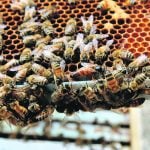Western Canadian feeder cattle prices traded $3 to as much as $10 below week ago levels due to deteriorating feedlot margins and building beef supplies. Once again the bulk of the pressure was on the heavier weight categories as the deferred live cattle futures made fresh contract lows. Alberta packers showed limited interest in fed cattle as the bulk of their nearby demand is covered. U.S. weekly production is coming in larger than expected and waning wholesale beef prices has set a negative tone. Feedlot margins were hovering in breakeven territory but are once again moving into red ink.
Read Also

U.S. grains: Soy futures post biggest monthly gain in nearly five years on China trade optimism
U.S. soybean futures climbed to a 15-month high and posted their biggest monthly gain in nearly five years on Friday following a rally fueled by the prospect of revived exports to China.
This past week was one of the hottest of the year with high humidity enhancing overall temperatures. Buyers and sellers did not want to transport cattle under these conditions which tempered market activity. Most auction barns experienced limited numbers making the market difficult to define. However, in Central Alberta, a small group of higher quality 875 pound Charolais cross steers dipped to $176 while 800 pound Angus-based steers were quoted at $180. Across the prairies, lighter steer calves weighing 500 to 600 pounds were quoted from $200 to $213 with heifers trading at a solid $15 discount.
US cattle on feed inventories as of July 1 were 1 per cent above year-ago levels while placements were up 3 per cent. Fed cattle marketings in June showed a year-over-year increase of 9 per cent and this trend is expected to continue throughout the summer. It’s preposterous to think the market has bottomed with this surge in third quarter beef production.
Fed cattle prices have divorced from wholesale and retail beef prices. The tenacity of retailers to maintain prices and margins has eliminated the potential for enhanced consumption. Therefore, one can make the argument that feeder cattle prices will only turnaround late in the fourth quarter when beef production eases.
— Jerry Klassen is manager of the Canadian office for Swiss-based grain trader GAP SA Grains and Produits. He is also president and founder of Resilient Capital, which specializes in proprietary commodity futures trading and commodity market analysis. Jerry owns farmland in Manitoba and Saskatchewan but grew up on a mixed farm/feedlot operation in southern Alberta, which keeps him close to the grassroots level of grain and cattle production. Jerry is a graduate of the University of Alberta. He can be reached at 204-504-8339.












